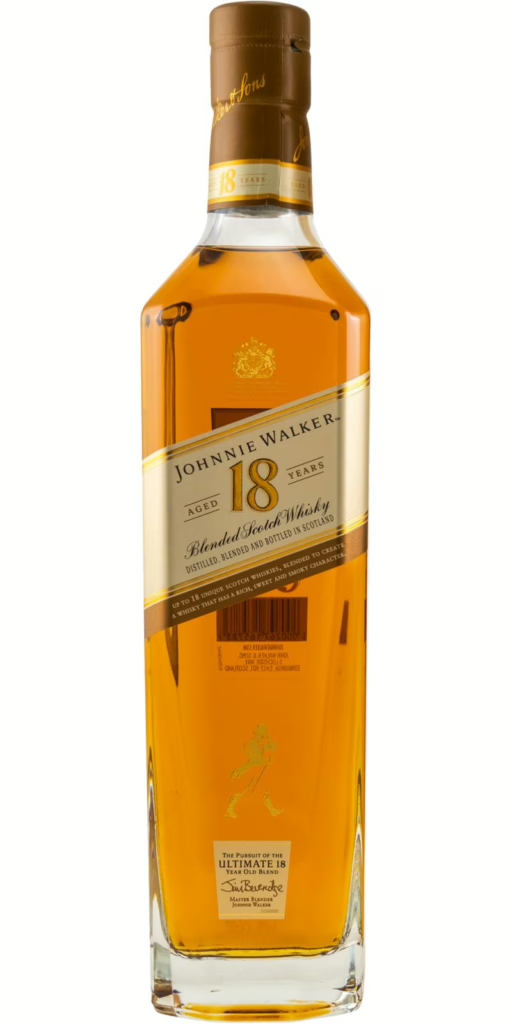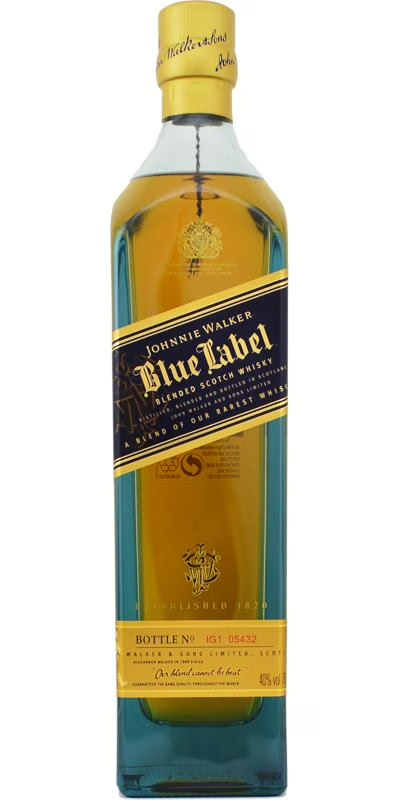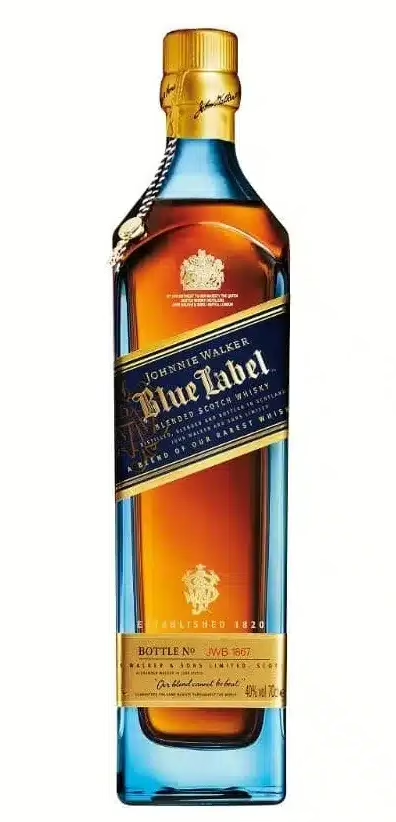Johnnie Walker is one of the most well-known Scotch whisky brands, established in 1820 by John Walker in Kilmarnock, Scotland. The brand’s square bottles and ‘Striding Man’ logo have made it instantly recognisable around the world. It produces a range of blended Scotch whiskies, catering to a variety of preferences, from everyday options to more premium releases. We’ll review today three whiskies sitting on the premium side, with the two Johnnie Walker Blue Label and the 18-Year-Old.
Johnnie Walker Blue Label
Johnnie Walker Blue Label is one of the brand’s high-end offerings, first introduced in 1992. It’s a blend made from some of Scotland’s rarer and older whiskies, including contributions from now-closed distilleries. The focus of Blue Label is to create a smooth and layered whisky with a balance of sweetness, smoke, and richness. Its reputation is built on the use of rare casks and the blending expertise behind its production, with a strong focus on emphasising its premium image through marketing.
There are also several variations of Blue Label, each highlighting specific aspects of whisky-making or commemorating particular themes:
- Ghost And Rare Editions
These releases highlight whiskies from closed distilleries (referred to as ‘ghost’ distilleries) combined with other rare casks. Examples include editions featuring Brora, Glenury Royal, or Pittyvaich, offering unique profiles based on these rare components. - Year of the Zodiac Editions
These annual releases coincide with Chinese New Year and feature bottle designs inspired by the Chinese zodiac. While the whisky remains consistent with standard Blue Label, the packaging is the main distinction. - King George V Edition
This version includes whiskies from distilleries that were active during the reign of King George V (1910–1936), including some from now-closed distilleries, such as Port Ellen. - 200th Anniversary Editions
Released in 2020 to mark the 200th anniversary of the brand, these editions included the ‘Legendary Eight’, a blend featuring whiskies from eight historic distilleries, and other limited-edition bottles designed to celebrate the milestone. - Cask Strength Editions
Occasionally, Blue Label has been released in cask-strength versions. These offer a more intense flavour and a different experience compared to the standard Blue Label, though they are relatively rare.
These variations aim to explore different facets of whisky blending, whether through the use of rare components, historical connections, or commemorative designs. While Blue Label and its editions are positioned as premium offerings, they remain a point of interest for those who appreciate blended Scotch whisky.
Enough talking, let’s get to the tasting part. Let’s use the 18-year-old as an aperitif before two Johnnie Walker Blue Label editions.
Johnnie Walker 18-year-old Review
Johnnie Walker Ultimate 18-Year-Old is a blend of up to 18 malt and grain whiskies, all aged for at least 18 years, though the exact number of components can vary. While the full list of whiskies used isn’t disclosed, the blend includes Speyside malts such as Cardhu, Glen Elgin, and Auchroisk, known for their sweetness, as well as Highland malts like Blair Athol, which contribute fruity and complex flavours. Island malts are also included, adding a touch of subtle smokiness. The whisky is bottled at 40% ABV, with chill filtration and likely the addition of colouring (E150). It is priced at around €70 in Europe and £70 in the UK.

Colour:
Chestnut (fake colouring)
Nose:
Neat: Orchard fruits and caramel lead the way, accompanied by a touch of grainy sharpness. As it sits, subtler notes emerge – custard, faint hints of smoke, and a touch of leather. Overall, the nose feels a bit reserved.
Palate:
Neat: The mouthfeel is creamier than expected, though still somewhat thin. Vanilla takes the lead, followed by a mild burst of spices. The profile then shifts toward bitter and sour notes – grapefruit, wood, lemon peel, and cardboard – balanced by a touch of icing sugar sweetness. Subtle pepper, dried herbs, a hint of gentle peat, and a few almonds.
Finish:
The finish brings notes of wood tannins, pepper, and a touch of orange peel, with a medium length.
Comments:
It’s not bad, but it’s not great either – just average and somewhat uninspiring. It’s the kind of whisky you could sip while watching TV, only to find your glass empty without any lasting impression. Smooth (as much as I dislike using that word, it fits perfectly here) but ultimately forgettable.
Rating: 5/10
Johnnie Walker Blue Label (±2018) Review
Johnnie Walker Blue Label is a non-age statement blended Scotch whisky with an undisclosed composition, at least for the standard release. It is bottled at 40% ABV, with added colouring and chill filtration. A full-size bottle typically costs around £175/€200 (it used to be £40 less at the time), housed in undeniably attractive packaging. This review is based on a 20 cl bottle I purchased at auction for £25 (excluding the auction premium), which I estimate to be from around 2018.

Colour:
Russet (fake colouring)
Nose:
Neat: Notes of vanilla, toffee, and malt sweetness are joined by hints of wood and delicate floral tones. Fruity layers emerge with peach, banana, and stewed apples, and the aroma of apricot-filled croissants. A subtle touch of essential oils as well – an inviting and pleasant nose.
Palate:
Neat: Peach and apple lead the way, followed by generous honey and a tangy note reminiscent of sour candies, with faint hints of pineapple in the background. The mouthfeel is slightly thin, though better than expected for a 40% ABV whisky. A bourbon-like sweetness suggests a grain whisky influence, but it feels well balanced, likely with a high proportion of malts in the blend. Subtle spices and a touch of woodiness come through next, with a hint of lemon pith.
Finish:
The finish offers notes of toffee, icing sugar, and milk chocolate, complemented by a touch of pepper and wood. Medium in length.
Comments:
It’s an improvement over the 18-year-old, offering more complexity, but at this price, you’d expect at least 43% or 46% ABV. That said, it’s unlikely to deter the target consumers who buy it for its price and attractive bottle, often treating it as a status symbol whilst casually sipping it with ice. Despite that, this Johnnie Walker Blue Label is still enjoyable and easy to drink. I’m glad I picked up a 200 ml bottle at auction for £25. And I’ll admit, the bottle is undeniably beautiful.
Rating: 6/10
Johnnie Walker Blue Label (±2021) Review
The second release of Johnnie Walker Blue Label I’m trying today is a more recent edition, which I estimate to be from around 2021. It comes from a sample pack that The Whisky Exchange released for the Virtual Whisky Show during the Covid pandemic. Like the earlier version, it’s coloured, chill-filtered, bottled at 40% ABV, and priced around £175/€200.

Colour:
Burnished (fake colouring)
Nose:
Neat: Honey, vanilla, and malt lead the nose, followed by the familiar scent of apricot-filled croissants. Apples and berries add a fruity sweetness, with a gentle hint of spices and light herbal notes.
Palate:
Neat: The mouthfeel is thinner than the 2018 version. It opens with spices and honey, offering a sweet arrival despite the peppery heat. Toasted oak adds bitterness, while notes of icing sugar, mandarin, cinnamon, toffee, and custard emerge. There’s also a faint hint of blond tobacco, like that of a cigarette.
Finish:
The finish offers a pleasant warmth, accompanied by a light sour note, but it’s relatively short-lived.
Comments:
This is a clear example of batch variation: while it shares similarities with the 2018, this edition of Johnnie Walker Blue Label feels less engaging on the palate. There’s honey, spices, and bitter toasted oak, but not much else. It’s not a bad whisky, but it’s quite boring and certainly not worth the price. I don’t factor price into my whisky ratings, but if I did, I’d take off at least one, maybe two points. I really cannot recommend this whisky.